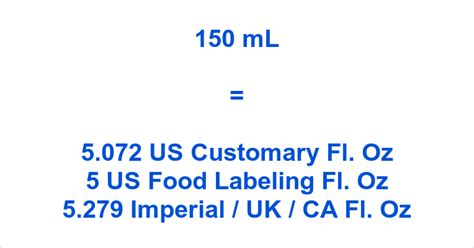150 Ml Is How Many Ounces
Kalali
Apr 02, 2025 · 4 min read

Table of Contents
150 ml is How Many Ounces? A Comprehensive Guide to Metric and Imperial Conversions
Understanding unit conversions is crucial in various aspects of life, from cooking and baking to scientific research and international trade. One common conversion that often causes confusion is converting milliliters (ml) to ounces (oz). This comprehensive guide will delve deep into the conversion of 150 ml to ounces, explaining the process, addressing common misconceptions, and providing valuable insights into metric and imperial systems.
Understanding the Units: Milliliters and Ounces
Before diving into the conversion, let's clarify the units involved:
-
Milliliters (ml): This is a unit of volume in the metric system. The metric system is based on powers of 10, making conversions relatively straightforward. A milliliter is one-thousandth of a liter (1/1000 L).
-
Ounces (oz): This is a unit of volume in the imperial system, a system of measurement predominantly used in the United States and a few other countries. The imperial system lacks the consistent decimal structure of the metric system, making conversions more complex. There are fluid ounces (fl oz) used for measuring liquids and avoirdupois ounces used for measuring weight. When dealing with volume conversions, we always refer to fluid ounces (fl oz).
Converting 150 ml to Ounces: The Calculation
The exact conversion factor between milliliters and fluid ounces is approximately 1 ml = 0.033814 fl oz. Therefore, to convert 150 ml to ounces, we simply multiply:
150 ml * 0.033814 fl oz/ml ≈ 5.0721 fl oz
Therefore, 150 ml is approximately equal to 5.07 fluid ounces.
Rounding for Practical Purposes
Depending on the context, you might round the result to a more convenient number. For everyday purposes, rounding to one decimal place (5.1 fl oz) is often sufficient. However, for scientific or precise measurements, it's recommended to retain more decimal places or use the exact conversion factor to minimize error.
Common Misconceptions and Pitfalls
Several misconceptions surround metric-imperial conversions:
-
Assuming a simple ratio: People sometimes mistakenly assume a simple whole-number ratio between milliliters and ounces, leading to inaccurate conversions. Remember, the conversion factor is not a whole number.
-
Confusing weight and volume: It's crucial to distinguish between weight (mass) and volume. While ounces can represent both weight (avoirdupois ounces) and volume (fluid ounces), milliliters are strictly a unit of volume. Confusing these can lead to significant errors.
-
Inconsistent rounding: Inconsistent rounding can introduce significant errors in calculations, especially when dealing with multiple conversions. Establish a clear rounding policy at the beginning of your calculations and stick to it consistently.
Beyond 150 ml: Practical Applications and Conversion Tools
Understanding the conversion of 150 ml to ounces is useful in many situations:
-
Cooking and Baking: Many recipes, particularly those from different regions, might use different units of measurement. Being able to accurately convert between milliliters and ounces ensures consistent results.
-
Medicine: Accurate dosage in medicine is critical. Converting units is crucial for proper administration of medication, especially when dealing with international pharmaceutical standards.
-
Science and Research: Scientific experiments often require precise measurements. Accurate conversions between metric and imperial units are essential for data consistency and analysis.
-
International Trade: Global trade involves dealing with various measurement systems. Accurate conversion is crucial to avoid misunderstandings and errors in shipping, logistics, and pricing.
Numerous online tools and converters are available to simplify the conversion process. These tools often offer high accuracy and can handle various units of measurement. However, understanding the underlying principles of the conversion is essential to avoid relying solely on these tools without grasping the fundamental concepts.
Expanding Your Conversion Skills: Mastering Other Units
While this guide focuses on 150 ml to ounces, mastering other conversions will enhance your understanding of measurement systems:
-
Liters to Gallons: Converting liters to gallons involves a similar process, requiring a specific conversion factor. Understanding this conversion is helpful in fuel efficiency calculations, liquid storage, and other applications.
-
Grams to Ounces (weight): Unlike fluid ounces, understanding the conversion between grams (a unit of mass) and ounces (avoirdupois ounces) is essential when dealing with weights of goods or ingredients.
-
Celsius to Fahrenheit: This temperature conversion is particularly useful for interpreting weather reports, cooking temperatures, and scientific experiments.
Mastering these and other conversions will broaden your ability to work confidently with measurements in various contexts.
Conclusion: Accuracy and Understanding in Conversions
Converting 150 ml to ounces is a straightforward process once you understand the conversion factor and the distinctions between the metric and imperial systems. However, accuracy is crucial, especially in contexts where precision is critical. Avoiding common misconceptions, using consistent rounding techniques, and understanding the underlying principles of the conversion will ensure accurate and reliable results. Remember that while online tools can assist, a solid grasp of the fundamental conversion principles empowers you to confidently navigate the world of measurements.
Latest Posts
Latest Posts
-
72 Inches Is How Many Cm
Apr 03, 2025
-
17 Out Of 18 As A Percentage
Apr 03, 2025
-
How Does Erosion Change The Surface Of The Earth
Apr 03, 2025
-
What Type Of Symmetry Do Mollusks Have
Apr 03, 2025
-
Least Common Factor Of 8 And 9
Apr 03, 2025
Related Post
Thank you for visiting our website which covers about 150 Ml Is How Many Ounces . We hope the information provided has been useful to you. Feel free to contact us if you have any questions or need further assistance. See you next time and don't miss to bookmark.
